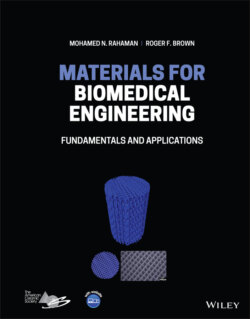Читать книгу Materials for Biomedical Engineering - Mohamed N. Rahaman - Страница 126
Solution:
ОглавлениеAs the elongation at the highest force is small, only 1.3% of the original length, the engineering values of the stress and strain are almost identical to their true values and, thus, we can use the engineering values. While the data can be converted to stress and strain, it is not necessary in solving this problem as the area remains nearly constant during the deformation. It is often preferable to determine the requisite properties from a plot of force versus elongation but due to the simple nature of the data in this problem, we will determine them directly from an examination of the data.
1 The Young’s modulus is the slope of the linear part of the stress versus strain curve. Examining the data we find that the force increases linearly with elongation up to a force of 92 649 N. The stress σ at this point is given by where d = 12.8 × 10−3 m is the diameter of the specimen. Substituting for d gives σ = 720 × 106 Pa or 720 MPa. The strain ε at this point is the elongation divided by the original length, equal to 0.36 ÷ 60.00 = 0.006 (or 0.6%). The Young’s modulus is 720 × 106 Pa ÷ 0.006 = 120 × 109 Pa or 120 GPa.
2 The stress–strain curve becomes nonlinear above a force of 92 649 N. Although the changeover from elastic to plastic deformation cannot be accurately determined, to a high approximation, the elastic limit is the stress or strain found in part (a), that is σ = 720 MPa or ε = 0.006.
3 Based on the slowly varying force above the elastic limit, this material does not show a clearly defined yield point. Thus, the yield stress σy will be taken as the stress at an offset strain of 0.002 or an offset elongation of 0.12 mm. Starting at this elongation, a line parallel to the linear portion of the force versus elongation data will intersect the force data at approximately 109 506 N. Dividing this force by the cross‐sectional area of the specimen gives σy = 851 MPa.
It is left as an exercise to confirm these mechanical properties from a plot of force versus extension.
